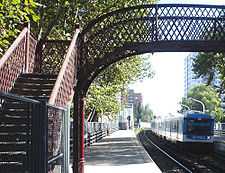Trenes de Buenos Aires
 | |
|
A Sarmiento line electric train in 2007. | |
| Sociedad Anónima | |
| Industry | Public transport |
| Fate | Dissolved |
| Predecessor | FEMESA |
| Successor | UGOMS |
| Founded | 1995 |
| Founder | Claudio and Mario Cirigliano |
| Defunct | 2012 |
| Headquarters | Argentina |
Area served |
City of Buenos Aires Greater Buenos Aires |
| Services | Rail transport |
| USD 135,1 million (1998) | |
| Owner | Grupo Plaza |
Number of employees | 4,340 |
| Divisions |
Mitre Sarmiento |
Trenes de Buenos Aires (TBA) (In English: Trains of Buenos Aires) was a private company that operated commuter rail services over 5 ft 6 in (1,676 mm) broad gauge Sarmiento and Mitre lines of Buenos Aires. The company, owned by Claudio and Mario Cirigliano, also operated long-distance services of Ferrocarril Mitre to Santa Fe Province.
From 2004 to 2012 TBA - a company part of the Plaza Group, controlled by the Cirigliano family-[1] also formed part of the consortium Unidad de Gestión Operativa Ferroviaria de Emergencia (UGOFE) which operated other commuter rail services in Buenos Aires.
History
TBA was established in 1995 after the Carlos Menem's administration privatized all the railway network, giving the company concession to operate metropolitan railway lines, Mitre and Sarmiento by Decree N° 730/95. The company took over both lines on May 27.
During the first two years of concession, TBA met the requeriments specified on the contract, about the frequency of the service, with an average of 98%. By February 1999 the consortium had invested USD 200 million including the reconstruction of 220 Toshiba wagons, the remodelation of 13 stations and workshops. In addition, a new ticket selling system was introduced with the installation of vending machines.
One of the most notable improvements was the introduction of "Puma" coaches in the Retiro-Tigre branch. This coaches were built by local factory Emprendimientos Ferroviarios S.A. (EMFER) and featured air conditioning, ABS brakes and computer-supervising systems.[2]
In 1997 the Government decided to modify the contracts of concession with a plan of modernization for USD 2,500 million. The future investments required to acquire 492 brand-new electric multiple units, refurbishing of more than 100 km of existing tracks, and the installation of new signalling, among other improvements.
Nevertheless, the Government of Fernando De la Rúa (who had come to power in 1999) made changes to the original project, reducing the amount of the budget to USD 1,300 million. To a compensation to the companies, the State granted subsidies to TBA (and the rest of the private operators) as a way to compensate the losses and avoid tariffs to increase.
In addition to the commuter rail services on Sarmiento and Mitre Line, TBA also operated the long-distance passenger trains from Retiro to the cities of Rosario, Santa Fe, and points between, in northern Argentina. Including all its commuter and long-distance services, the company runs approximately 1,000 trains per day and conveys about 147.7 million passengers annually, or 500,000 daily.
Since 2004 the company also formed part of Unidad de Gestión Operativa Ferroviaria de Emergencia (UGOFE), a consortium with railway companies Metrovías and Ferrovías, which took over the running of commuter rail services on Belgrano Sur, Roca and San Martín lines in Buenos Aires after concessions granted to Metropolitano S.A. for the operation of these services were revoked.
Following a commuter train accident on February 22, 2012, at Once Station, Buenos Aires, in which 51 people died and at least 703 people were injured,[3] TBA was placed under federal intervention on February 28; its concessions to operate the Mitre and Sarmiento lines were ultimately revoked on May 24.[4] After the cancellation of the contact, both lines were took over by the consortium Unidad de Gestión Operativa Mitre Sarmiento (UGOMS).
Gallery
References
- ↑ "Un imperio llamado familia Cirigliano", Agencia CNA, 4 Jun 2010
- ↑ Detalle de los coches Puma en sitio web de EMFER (Archive)
- ↑ "Argentina train crash in Buenos Aires kills dozens". BBC News. Retrieved 2012-02-22.
- ↑ "Finalmente, el Gobierno le sacó las concesiones del Sarmiento y del Mitre a TBA". Clarín.
External links
- Official website (Archive) Feb 1, 2012
| ||||||||||||||||








